- School of Science, Harbin Institute of Technology (Shenzhen), Shenzhen, China
Identical hard spheres in cylindrical confinement exhibit a rich variety of densest-packed columnar structures. Such structures, which generally vary with the corresponding cylinder-to-sphere diameter ratio D, serve as structural models for a variety of experimental systems at the micro- or nano-scale. In this research, the electrical conductivity as a function of D has been studied for four different types of such columnar structures. It was found that, for increasing D, the electrical conductivity of each type of structures decreases monotonously, as a result of the system’s resistive components becoming more densely packed along the long axis of the cylindrical space. However, there exists a discontinuous rise in the system’s electrical conductivity at
1 Introduction
Packing problems [1], which concern the optimal arrangements of objects in space, have historically been of great interest to both physicists and mathematicians. Such problems not only pose sufficient intellectual challenges for mathematicians [2], but they also yield solutions that physicists can use as theoretical models to understand the structures of matter [3–6]. Prominent examples include the application of the face-centered cubic (fcc) and hexagonal close-packed (hcp) structures as models for bulk crystal structures of solids [4] and the application of random close packings as models for bulk amorphous structures of liquids [3, 6]. In contrast to these examples for bulk systems, the past few decades have seen an uprising interest in the packings of particles in confined settings, such as those of particles confined within a two-dimensional box [7, 8], within a parallel strip [9–14], within a spherical container [15, 16], within a cylindrical container [17–36], onto a cylindrical surface [37], between parallel plates [38–46], within a wedge cell [47, 48], or within a flexible container [49]. In particular, for packings of identical spheres in cylindrical confinement, more than fifty densest-packed columnar structures have been discovered within a relatively narrow range of the cylinder-to-sphere diameter ratio D [17, 22, 24, 29, 30] where, intriguingly, many of such columnar structures exhibit unexpected chirality despite the simplicity of the confining cylindrical geometry. On the other hand, such columnar structures of spheres have been observed for a variety of experimental systems at both the micro- [50–56] and the nano-scale [57–63]. This problem of confined packings has recently been extended to shape-anisotropic particles [13, 14, 36, 37], for which a variety of confinement-induced crystal structures with specific orientational order have been discovered.
The research described above focussed on the structural aspects of the corresponding densest-packed arrangements of particles. For each densest-packed structure, those studies mainly involved a characterisation of the packing fraction and contact network and an investigation of the underlying mechanism of confinement-induced geometric frustration. Not only have the theoretical findings helped us understand better the structural properties of some existing experimental systems; they can also serve as a basis for the design of quasi-one-dimensional materials with designated physical properties. From the viewpoint of materials design, however, it is also important to understand how the macroscopic mechanical, electrical or optical properties of a system depend on the microscopic arrangements of its constituents, because an understanding of such structure-property relationships would allow those macroscopic properties to be tailored via a controlled microscopic assembly of the system’s constituents. Following this spirit, we have investigated how the electrical conductivity of a densest-packed columnar structure of identical spheres in cylindrical confinement depends on the underlying microscopic arrangement of spheres and how this property varies with the cylinder-to-sphere diameter ratio D. The structures investigated were the zigzag structures at
This paper is organized as follows: In Section 2, we introduce the resistor-network model [67] as employed in our study of electrical conductivity. In Sections 3–5, we present an analytic derivation of the electrical conductivity σ as a function of D for, respectively, the zigzag structures at
2 Resistor-Network Model
For any pair of touching spheres with a potential difference Δψ and with a current I that flows from one sphere to the other, the inter-particle resistance R, which takes into account the bulk resistance of each sphere and the contact resistance between the spheres, is defined as
and is modelled by a resistor that joins the centres of the spheres. The contact resistance is thought to be arising from a negligibly small overlap between the spheres. Let dc be the cross-sectional diameter of the overlap volume and d the diameter of either sphere. The ratio dc/d is then a measure of the extent of inter-sphere overlap. Figure 1 shows that, as this ratio decreases, the inter-particle resistance R increases monotonously. We assume the value of dc/d to be sufficiently small such that, while the value of R remains finite, any uncertainty in the value of D can be ignored.
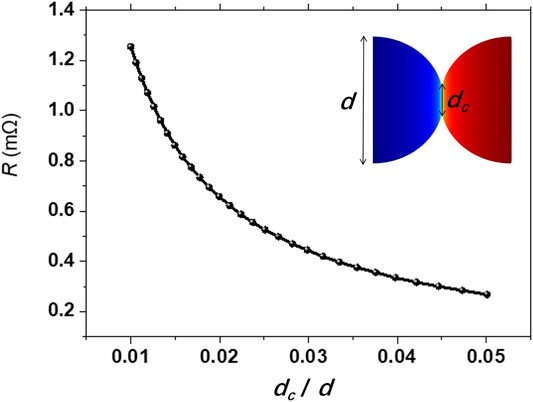
FIGURE 1. Plot of the inter-particle resistance R as a function of dc/d for a pair of touching spheres, where dc is the cross-sectional diameter of the overlap volume and d the diameter of either sphere. The results were obtained from COMSOL simulations. As the ratio dc/d decreases, the inter-particle resistance R increases monotonously. In our resistor-network model, we assume the value of dc/d to be sufficiently small such that, while the value of R remains finite, any uncertainty in the value of D can be ignored.
In principle, for such columnar structures, the electrical conductivity σ as a function of D can be derived by considering the spatial distribution of resistors within the confining cylindrical space. For any assembly of identical spheres, we take the value of R to be the same for any pair of touching spheres. Since our focus is on the conducting behaviour of the confined spheres, we simplify our problem by assuming all other regions of the confining cylindrical space to be electrically insulating, such that we only need to be concerned with the conducting paths across the assembly of spheres. For each type of structures, we replace each pair of touching spheres by a resistor, identify the corresponding spatial distribution of resistors, and apply Kirchhoff’s laws with some symmetry considerations to derive an analytic expression for the electrical conductivity of an infinitely long structure.
3 Zigzag Structures at
Consider the zigzag structures at
if the diameter of each sphere is taken to be unity. The electrical conductivity σ as a function of D can be derived by considering an equivalent linear chain of resistors, in which each resistive component occupies a cylindrical space of length (Δz)D and cross-sectional area AD = π(D/2)2:
where, for increasing D, the numerator and denominator of this expression for the rescaled conductivity σ′ decreases and increases, respectively. This corresponds to a monotonous decrease in σ′, as the columnar structure becomes thicker in diameter and the resistors inside become more densely packed along the long axis of the cylindrical space.
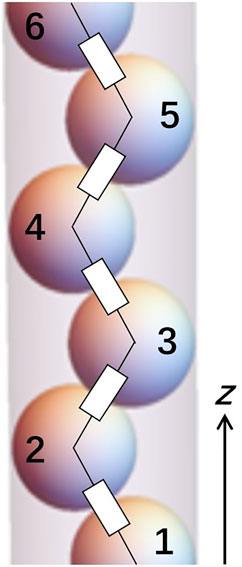
FIGURE 2. Schematic illustration of a zigzag structure at
4 Single- and Double-Helix Structures at D < 2
The single-helix structures at
As illustrated in Figure 3, with additional resistors joining pairs of next-nearest neighbours, the resistor network of any single- or double-helix structure at D < 2 is no longer a simple chain of resistors and is therefore different from that of a zigzag structure. It reflects the presence of triplets of mutually touching spheres in the structure. But based on some symmetry considerations for an infinitely long structure, an equivalent linear chain of resistors can be derived from this more complex resistor network. The electrical conductivity σ as a function of D can then be derived be considering the length and cross-sectional area of the cylindrical space occupied by each resistive component in this equivalent circuit.
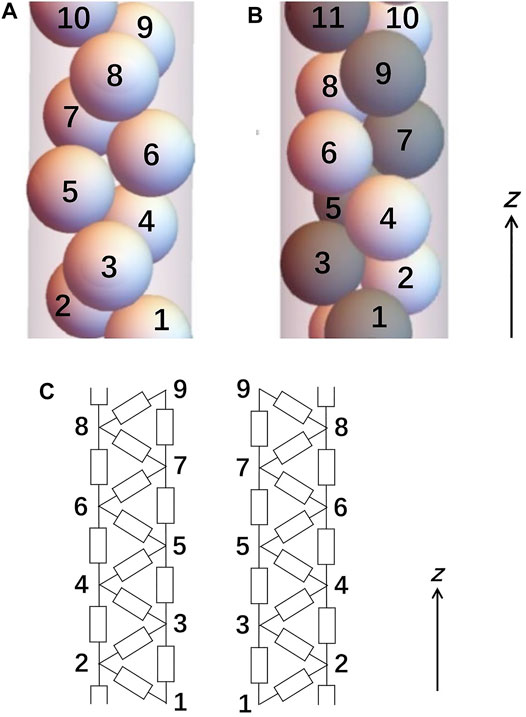
FIGURE 3. Schematic illustration of (A) a single-helix structure at
Consider the electrical circuit on the left-hand side of Figure 3C, and let Ii→j be the current that flows from sphere i to sphere j. Since this circuit is infinitely long, the circuital environment (i.e., the way a sphere is connected to all other components in the circuit) of sphere i ∈ (−∞, + ∞) is the same for respectively all even values of i and all odd values of i as a result of translational symmetry across the circuit. On the other hand, the equivalent mirror-symmetric circuit on the right-hand side of Figure 3C implies that the circuital environment is the same for all spheres regardless of whether their indices i are odd or even. It follows that the symmetry conditions
and
apply to any value of i. According to Kirchhoff’s current law, the total current that flows into any sphere i is equal to the total current that flows out of the same sphere:
This condition also follows naturally from the symmetry conditions I(i−1)→i = Ii→(i+1) and I(i−2)→i = Ii→(i+2), as described respectively by Eqs 4 and 5. On the other hand, let Vi→j = Ii→jR be the voltage across sphere i and sphere j. According to Kirchhoff’s voltage law, the voltage across any pair of spheres is path-independent, so that we can link up the voltages across nearest neighbours and those across next-nearest neighbours as follows:
A combination of Eqs 4 and 7 yields the following relation between Ii→(i+1) and Ii→(i+2):
such that the total current that flows across any sphere i is equal to
For any integer N, the voltage across sphere i and sphere (i + N) is a sum of the voltages across nearest neighbours:
This voltage can also be expressed in terms of the effective resistance Ri,(i+N) between sphere i and sphere (i + N):
where, according to Eq. 9, 3Ii→(i+1) is the total current that flows across either sphere. A combination of the above expressions for Vi→(i+N) reveals a simple proportionality between Ri,(i+N) and R:
It follows that the electrical conductivity of any single- or double-helix structure at D < 2 can be obtained from an equivalent linear chain of resistors in which the resistance of each component is equal to R/3. For any single-helix structure at
and cross-sectional area AD = π(D/2)2, so that the electrical conductivity σ as a function of D is given by
For the double-helix structures at
yields the following expression for the electrical conductivity as a function of D:
Like the case of zigzag structures, the rescaled conductivity σ′ of either type of helical structures at D < 2 decreases monotonously for increasing D, as the numerator and denominator in the corresponding expression decreases and increases, respectively.
5 Double-Helix Structures at
For the double-helix structures at
and
According to Kirchhoff’s current law, the total current that flows across sphere i is given by
which can also be written as
according to the above symmetry conditions for next-nearest neighbours. This implies
On the other hand, according to Kirchhoff’s voltage law, we have the following conditions for the path independence of voltages:
and
Using the symmetry condition I(i+2)→(i+3) = Ii→(i+1), Eq. 23 can be written as
Substituting Eq. 34 into Eq. 22 yields
which implies
and hence
according to Eqs 21 and 24, respectively. For any integer N, the voltage across sphere i and sphere (i + 2N) is a sum of the voltages across next-nearest neighbours:
This voltage can also be expressed in terms of the effective resistance Ri,(i+2N) between sphere i and sphere (i + 2N):
for Itotal = 2Ii→(i+2). A combination of Eqs 29 and 30 yields
According to Eqs 12 and 31, there is a drop in the effective resistance Ri,(i+1) as the diameter ratio D increases beyond 2. This is attributed to the establishment of additional conducting paths across the system. For this type of helical structures, we have [69].
The electrical conductivity σ as a function of D is then given by
where, as in the case of the other types of structures, the rescaled conductivity σ′ decreases monotonously for increasing D.
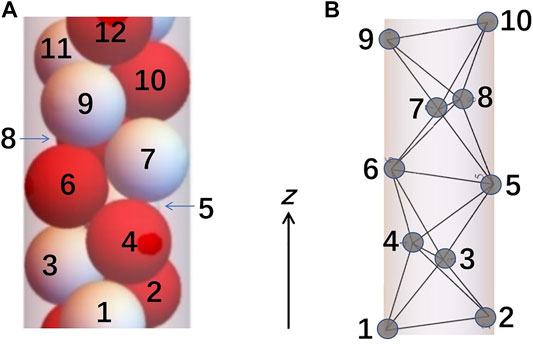
FIGURE 4. Schematic illustration of (A) a double-helix structure at
6 Results and Discussion
The rescaled electrical conductivity σ′ as a function of D has been derived for the zigzag structures at
As indicated by the inset of Figure 6, this volume fraction is continuous across every structural transition, as different from the case of σ′. Figure 7 shows a plot of σ′ as a function of VF. It was found that, for each type of helical structures, the rescaled electrical conductivity σ′ decreases monotonously for increasing VF. For the zigzag structures at
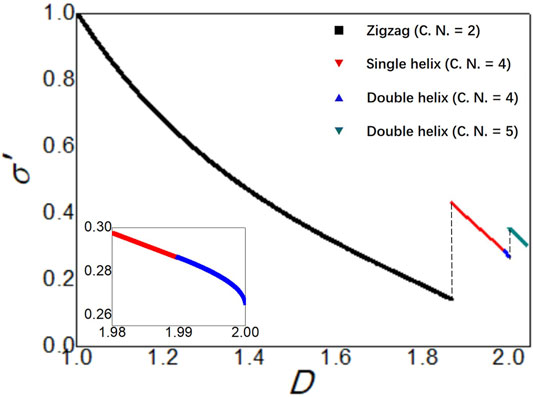
FIGURE 5. Plot of the rescaled electrical conductivity σ′ as a function of the cylinder-to-sphere diameter ratio D. The vertical dashed lines indicate a discontinuous rise in σ′ at
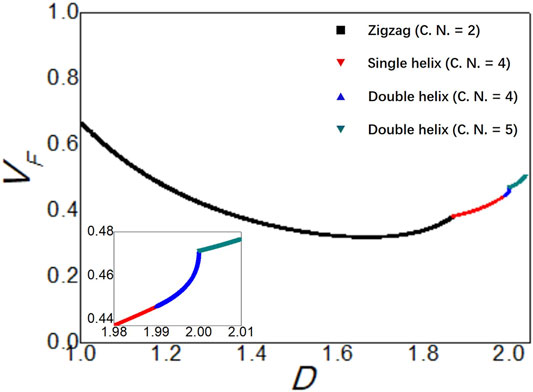
FIGURE 6. Plot of the volume fraction VF of spheres as a function of the cylinder-to-sphere diameter ratio D. The inset indicates that this volume fraction is continuous across each structural transition.
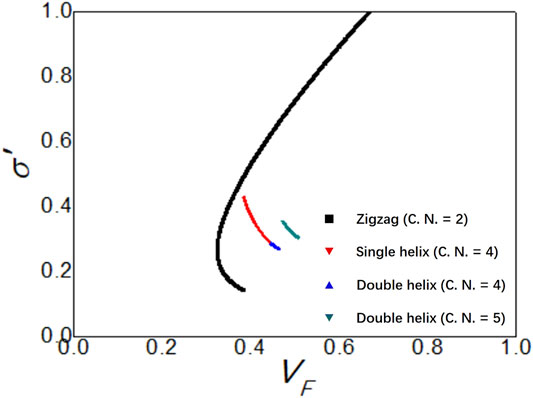
FIGURE 7. Plot of the rescaled electrical conductivity σ′ as a function of the volume fraction VF of spheres. For each type of helical structures, σ′ decreases monotonously for increasing VF. For the zigzag structures at
The results presented in Figure 5 could serve as a guide for the development of quasi-one-dimensional materials with a structurally tunable electrical conductivity. Any such experimental system should be a densest-packed assembly of conducting spherical particles immersed in an insulating medium. Once the inter-particle resistance R between any pair of touching spheres is known, the system’s electrical conductivity can be tuned to any designated value through a variation of D. On the other hand, the relation between σ′ and VF as presented in Figure 7 suggests that it is possible to characterise the volume fraction experimentally by means of electrical-conductivity measurements. In cases where the measured value of σ′ corresponds to two possible values of VF, i.e to two possible types of columnar structures, the correct type of structures can be determined from the corresponding measured value of D.
Data Availability Statement
The original contributions of this study are all included in the article. Further inquiries can be directed to the corresponding author.
Author Contributions
This research was jointly completed by PM and her research supervisor H-KC. The manuscript was mainly written up by H-KC.
Funding
This work was supported by the Science, Technology and Innovation Commission of Shenzhen Municipality (Grants No. JCYJ20160531193515801 and No. ED11409002).
Conflict of Interest
The authors declare that the research was conducted in the absence of any commercial or financial relationships that could be construed as a potential conflict of interest.
Publisher’s Note
All claims expressed in this article are solely those of the authors and do not necessarily represent those of their affiliated organizations, or those of the publisher, the editors and the reviewers. Any product that may be evaluated in this article, or claim that may be made by its manufacturer, is not guaranteed or endorsed by the publisher.
References
2. Hales T. A Proof of the Kepler Conjecture. Ann Math (2005) 162:1065–185. doi:10.4007/annals.2005.162.1065
3. Bernal JD. Geometry of the Structure of Monatomic Liquids. Nature (1960) 185:68–70. doi:10.1038/185068a0
4. Chaikin PM, Lubensky TC. Principles of Condensed Matter Physics. Cambridge: Cambridge University Press (2000).
5. Torquato S. Random Heterogeneous Materials: Microstructure and Macroscopic Properties. New York: Springer-Verlag (2002).
6. Finney JL. Bernal's Road to Random Packing and the Structure of Liquids. Philos Mag (2013) 93:3940–69. doi:10.1080/14786435.2013.770179
7. Aström JAM, Karttunen M. Cell Aggregation: Packing Soft Grains. Phys Rev E Stat Nonlin Soft Matter Phys (2006) 73:062301. doi:10.1103/PhysRevE.73.062301
8. Yao Z. Stress-Induced Ordering of Two-Dimensional Packings of Elastic Spheres. Phys Rev E (2020) 101:062904. doi:10.1103/PhysRevE.101.062904
9. Füredi Z. The Densest Packing of Equal Circles into a Parallel Strip. Discrete Comput Geom (1991) 6:95–106. doi:10.1007/bf02574677
10. Ashwin SS, Bowles RK. Complete Jamming Landscape of Confined Hard Discs. Phys Rev Lett (2009) 102:235701. doi:10.1103/physrevlett.102.235701
11. Yamchi MZ, Ashwin SS, Bowles RK. Inherent Structures, Fragility, and Jamming: Insights from Quasi-One-Dimensional Hard Disks. Phys Rev E Stat Nonlin Soft Matter Phys (2015) 91:022301. doi:10.1103/PhysRevE.91.022301
12. Martínez-Ratón Y, Velasco E. Highly Confined Mixtures of Parallel Hard Squares: A Density-Functional-Theory Study. Phys Rev E (2019) 100:062604. doi:10.1103/PhysRevE.100.062604
13. Jin W, Wang Y, Chan H-K, Zhong Z. Confinement-Induced Columnar Crystals of Ellipses. Phys Rev Res (2021) 3:013053. doi:10.1103/physrevresearch.3.013053
14. Basurto E, Gurin P, Varga S, Odriozola G. Anisotropy-Independent Packing of Confined Hard Ellipses. J Mol Liquids (2021) 333:115896. doi:10.1016/j.molliq.2021.115896
15. Winkler A, Statt A, Virnau P, Binder K. Phase Transitions and Phase Equilibria in Spherical Confinement. Phys Rev E (2013) 87:032307. doi:10.1103/physreve.87.032307
16. Curk T, Farrell JD, Dobnikar J, Podgornik R. Spontaneous Domain Formation in Spherically Confined Elastic Filaments. Phys Rev Lett (2019) 123:047801. doi:10.1103/PhysRevLett.123.047801
17. Pickett GT, Gross M, Okuyama H. Spontaneous Chirality in Simple Systems. Phys Rev Lett (2000) 85:3652–5. doi:10.1103/physrevlett.85.3652
18. Landry JW, Grest GS, Silbert LE, Plimpton SJ. Confined Granular Packings: Structure, Stress, and Forces. Phys Rev E Stat Nonlin Soft Matter Phys (2003) 67:041303. doi:10.1103/PhysRevE.67.041303
19. Landry JW, Grest GS. Granular Packings with Moving Side walls. Phys Rev E Stat Nonlin Soft Matter Phys (2004) 69:031303. doi:10.1103/PhysRevE.69.031303
20. Mueller GE. Numerically Packing Spheres in Cylinders. Powder Technol (2005) 159:105–10. doi:10.1016/j.powtec.2005.06.002
21. Theuerkauf J, Witt P, Schwesig D. Analysis of Particle Porosity Distribution in Fixed Beds Using the Discrete Element Method. Powder Technol (2006) 165:92–9. doi:10.1016/j.powtec.2006.03.022
22. Mughal A, Chan HK, Weaire D. Phyllotactic Description of Hard Sphere Packing in Cylindrical Channels. Phys Rev Lett (2011) 106:115704. doi:10.1103/physrevlett.106.115704
23. Chan HK. Densest Columnar Structures of Hard Spheres from Sequential Deposition. Phys Rev E Stat Nonlin Soft Matter Phys (2011) 84:050302. doi:10.1103/PhysRevE.84.050302
24. Mughal A, Chan HK, Weaire D, Hutzler S. Dense Packings of Spheres in Cylinders: Simulations. Phys Rev E Stat Nonlin Soft Matter Phys (2012) 85:051305. doi:10.1103/PhysRevE.85.051305
25. Chan H-K. A Hybrid Helical Structure of Hard-Sphere Packing from Sequential Deposition. Philos Mag (2013) 93:4057–69. doi:10.1080/14786435.2013.801568
26. Mughal A. Screw Symmetry in Columnar Crystals. Philos Mag (2013) 93:4070–7. doi:10.1080/14786435.2013.817691
27. Mughal A, Weaire D. Theory of Cylindrical Dense Packings of Disks. Phys Rev E Stat Nonlin Soft Matter Phys (2014) 89:042307. doi:10.1103/PhysRevE.89.042307
28. Yamchi MZ, Bowles RK. Helical Defect Packings in a Quasi-One-Dimensional System of Cylindrically Confined Hard Spheres. Phys Rev Lett (2015) 115:025702. doi:10.1103/PhysRevLett.115.025702
29. Fu L, Steinhardt W, Zhao H, Socolar JES, Charbonneau P. Hard Sphere Packings within Cylinders. Soft Matter (2016) 12:2505–14. doi:10.1039/c5sm02875b
30. Fu L, Bian C, Shields CW, Cruz DF, López GP, Charbonneau P. Assembly of Hard Spheres in a cylinder: A Computational and Experimental Study. Soft Matter (2017) 13:3296–306. doi:10.1039/c7sm00316a
31. Mughal A, Winkelmann J, Weaire D, Hutzler S. Columnar Structures of Soft Spheres: Metastability and Hysteresis. Phys Rev E (2018) 98:043303. doi:10.1103/physreve.98.043303
32. Winkelmann J, Haffner B, Weaire D, Mughal A, Hutzler S. Corrected Article: Simulation and Observation of Line-Slip Structures in Columnar Structures of Soft Spheres [Phys. Rev. E 96, 012610 (2017)]. Phys Rev E (2018) 97:059902. doi:10.1103/PhysRevE.97.059902
33. Winkelmann J, Mughal A, Williams DB, Weaire D, Hutzler S. Theory of Rotational Columnar Structures of Soft Spheres. Phys Rev E (2019) 99:020602. doi:10.1103/PhysRevE.99.020602
34. Winkelmann J, Mughal A, Weaire D, Hutzler S. Equilibrium Configurations of Hard Spheres in a Cylindrical Harmonic Potential. EPL (2019) 127:44002. doi:10.1209/0295-5075/127/44002
35. Chan H-K, Wang Y, Han H. Densest Helical Structures of Hard Spheres in Narrow Confinement: An Analytic Derivation. AIP Adv (2019) 9:125118. doi:10.1063/1.5131318
36. Jin W, Chan H-K, Zhong Z. Shape-Anisotropy-Induced Ordered Packings in Cylindrical Confinement. Phys Rev Lett (2020) 124:248002. doi:10.1103/physrevlett.124.248002
37. Liu H, Zong Y, Zu M, Mason TG, Ye F, Zhao K. Curvature-Assisted Self-Assembly of Brownian Squares on Cylindrical Surfaces. J Colloid Interf Sci (2022) 605:863–70. doi:10.1016/j.jcis.2021.07.123
38. Zangi R, Rice SA. Nature of the Transition from Two- to Three-Dimensional Ordering in a Confined Colloidal Suspension. Phys Rev E (2000) 61:660–70. doi:10.1103/physreve.61.660
39. Cohen I, Mason TG, Weitz DA. Shear-Induced Configurations of Confined Colloidal Suspensions. Phys Rev Lett (2004) 93:046001. doi:10.1103/PhysRevLett.93.046001
40. García-Castillo A, Arauz-Lara JL. Static Structure of Confined Dumbbell-Sphere Colloidal Mixtures. Phys Rev E Stat Nonlin Soft Matter Phys (2008) 78:020401. doi:10.1103/PhysRevE.78.020401
41. Desmond KW, Weeks ER. Random Close Packing of Disks and Spheres in Confined Geometries. Phys Rev E Stat Nonlin Soft Matter Phys (2009) 80:051305. doi:10.1103/PhysRevE.80.051305
42. Camenen JF, Descantes Y, Richard P. Effect of Confinement on Dense Packings of Rigid Frictionless Spheres and Polyhedra. Phys Rev E Stat Nonlin Soft Matter Phys (2012) 86:061317. doi:10.1103/PhysRevE.86.061317
43. Oğuz EC, Marechal M, Ramiro-Manzano F, Rodriguez I, Messina R, Meseguer FJ, et al. Packing Confined Hard Spheres Denser with Adaptive Prism Phases. Phys Rev Lett (2012) 109:218301. doi:10.1103/PhysRevLett.109.218301
44. Chen D, Torquato S. Confined Disordered Strictly Jammed Binary Sphere Packings. Phys Rev E Stat Nonlin Soft Matter Phys (2015) 92:062207. doi:10.1103/PhysRevE.92.062207
45. Deißenbeck F, Löwen H, Oğuz EC. Ground State of Dipolar Hard Spheres Confined in Channels. Phys Rev E (2018) 97:052608. doi:10.1103/PhysRevE.97.052608
46. Jung G, Petersen CF. Confinement-Induced Demixing and Crystallization. Phys Rev Res (2020) 2:033207. doi:10.1103/physrevresearch.2.033207
47. Ramiro-Manzano F, Bonet E, Rodriguez I, Meseguer F. Layering Transitions in Confined Colloidal Crystals: The Hcp-Like Phase. Phys Rev E Stat Nonlin Soft Matter Phys (2007) 76:050401. doi:10.1103/PhysRevE.76.050401
48. Liu B, Besseling TH, van Blaaderen A, Imhof A. Confinement Induced Plastic Crystal-to-Crystal Transitions in Rodlike Particles with Long-Ranged Repulsion. Phys Rev Lett (2015) 115:078301. doi:10.1103/PhysRevLett.115.078301
49. Maibaum L, Schmidt M, Löwen H. Colloids Confined to a Flexible Container. Phys Rev E Stat Nonlin Soft Matter Phys (2001) 63:051401. doi:10.1103/PhysRevE.63.051401
50. Moon JH, Kim S, Yi G-R, Lee Y-H, Yang S-M. Fabrication of Ordered Macroporous Cylinders by Colloidal Templating in Microcapillaries. Langmuir (2004) 20:2033–5. doi:10.1021/la0358015
51. Li F, Badel X, Linnros J, Wiley JB. Fabrication of Colloidal Crystals with Tubular-Like Packings. J Am Chem Soc (2005) 127:3268–9. doi:10.1021/ja042928n
52. Tymczenko M, Marsal LF, Trifonov T, Rodriguez I, Ramiro-Manzano F, Pallares J, et al. .Colloidal Crystal Wires. Adv Mater (2008) 20:2315–8. doi:10.1002/adma.200701526
53. Vanapalli SA, Iacovella CR, Sung KE, Mukhija D, Millunchick JM, Burns MA, et al. Fluidic Assembly and Packing of Microspheres in Confined Channels. Langmuir (2008) 24:3661–70. doi:10.1021/la703840w
54. Meagher AJ, García-Moreno F, Banhart J, Mughal A, Hutzler S. An Experimental Study of Columnar Crystals Using Monodisperse Microbubbles. Colloids Surf A: Physicochemical Eng Aspects (2015) 473:55–9. doi:10.1016/j.colsurfa.2014.12.020
55. Lee T, Gizynski K, Grzybowski BA. Non-Equilibrium Self-Assembly of Monocomponent and Multicomponent Tubular Structures in Rotating Fluids. Adv Mater (2017) 29:1704274. doi:10.1002/adma.201704274
56. Wu G, Cho H, Wood DA, Dinsmore AD, Yang S. Confined Assemblies of Colloidal Particles with Soft Repulsive Interactions. J Am Chem Soc (2017) 139:5095–101. doi:10.1021/jacs.6b12975
57. Mickelson W, Aloni S, Han W-Q, Cumings J, Zettl A. Packing C 60 in Boron Nitride Nanotubes. Science (2003) 300:467–9. doi:10.1126/science.1082346
58. Khlobystov AN, Britz DA, Ardavan A, Briggs GAD. Observation of Ordered Phases of Fullerenes in Carbon Nanotubes. Phys Rev Lett (2004) 92:245507. doi:10.1103/physrevlett.92.245507
59. Cong VT, Ganbold E-O, Saha JK, Jang J, Min J, Choo J, et al. .Gold Nanoparticle Silica Nanopeapods. J Am Chem Soc (2014) 136:3833–41. doi:10.1021/ja411034q
60. Liang R, Xu J, Deng R, Wang K, Liu S, Li J, et al. .Assembly of Polymer-Tethered Gold Nanoparticles under Cylindrical Confinement. ACS Macro Lett (2014) 3:486–90. doi:10.1021/mz5002146
61. Sanwaria S, Horechyy A, Wolf D, Chu C-Y, Chen H-L, Formanek P, et al. .Helical Packing of Nanoparticles Confined in Cylindrical Domains of a Self-Assembled Block Copolymer Structure. Angew Chem Int Ed (2014) 53:9090–3. doi:10.1002/anie.201403565
62. Chen Z, Ye S, Evans SD, Ge Y, Zhu Z, Tu Y, et al. .Confined Assembly of Hollow Carbon Spheres in Carbonaceous Nanotube: A Spheres-In-Tube Carbon Nanostructure with Hierarchical Porosity for High-Performance Supercapacitor. Small (2018) 14:1704015. doi:10.1002/smll.201704015
63. Zhang F, Liu R, Wei Y, Wei J, Yang Z. Self-Assembled Open Porous Nanoparticle Superstructures. J Am Chem Soc (2021) 143:11662–9. doi:10.1021/jacs.1c04784
64. Kirkpatrick S. Percolation and Conduction. Rev Mod Phys (1973) 45:574–88. doi:10.1103/revmodphys.45.574
65. Swensen JP, Dollar AM. The Connectedness of Packed Circles and Spheres with Application to Conductive Cellular Materials. PLoS ONE (2012) 7:e51695. doi:10.1371/journal.pone.0051695
66. Birkholz O, Gan Y, Kamlah M. Modeling the Effective Conductivity of the Solid and the Pore Phase in Granular Materials Using Resistor Networks. Powder Technol (2019) 351:54–65. doi:10.1016/j.powtec.2019.04.005
67. Ma P. A Theoretical Study of the Electrical Resistivities of Densest-Packed crystal Structures of Spheres in Cylindrical Confinement. Master thesis. Shenzhen: Harbin Institute of Technology (2020).
68. Birkholz O, Neumann M, Schmidt V, Kamlah M. Statistical Investigation of Structural and Transport Properties of Densely-Packed Assemblies of Overlapping Spheres Using the Resistor Network Method. Powder Technol (2021) 378:659–66. doi:10.1016/j.powtec.2020.09.056
Keywords: packing, structure, conductivity, resistor network, sphere, helix, zigzag, confinement
Citation: Ma P and Chan H-K (2021) Densest-Packed Columnar Structures of Hard Spheres: An Investigation of the Structural Dependence of Electrical Conductivity. Front. Phys. 9:778001. doi: 10.3389/fphy.2021.778001
Received: 16 September 2021; Accepted: 04 October 2021;
Published: 05 November 2021.
Edited by:
Yang Jiao, Arizona State University, United StatesReviewed by:
Duyu Chen, University of California, Santa Barbara, United StatesRichard Bowles, University of Saskatchewan, Canada
Copyright © 2021 Ma and Chan. This is an open-access article distributed under the terms of the Creative Commons Attribution License (CC BY). The use, distribution or reproduction in other forums is permitted, provided the original author(s) and the copyright owner(s) are credited and that the original publication in this journal is cited, in accordance with accepted academic practice. No use, distribution or reproduction is permitted which does not comply with these terms.
*Correspondence: Ho-Kei Chan, ZXBrZWl5ZWFoQHlhaG9vLmNvbS5oaw==
 Panpan Ma
Panpan Ma Ho-Kei Chan
Ho-Kei Chan